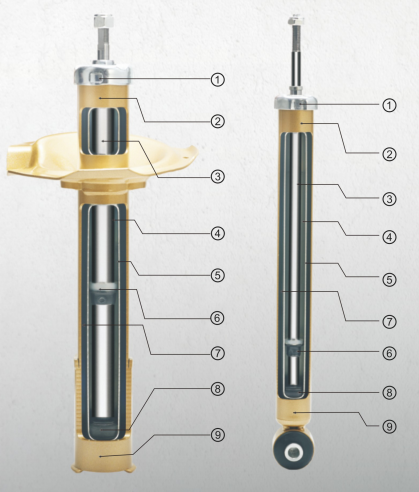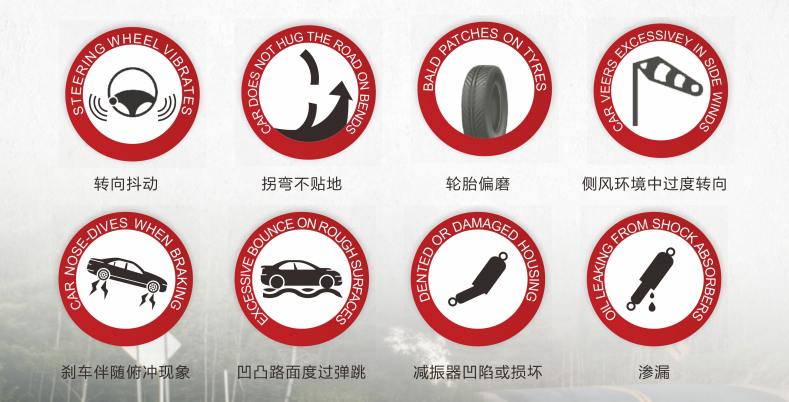Shock absorbers are critical components of a vehicles' suspension. They are designed to help to control the impact and rebound movement of the vehicle's springs and suspension. Along with smoothening out bumps and vibrations, the key role of the shock absorber is to ensure that the vehicle's tires remain in contact with the ground at all times, which ensures the safest control and braking response from your car.

Annotation:① OIL SEAL ② ROD GUIDE ③ PISTON ROD ④ SHOCK ABSORBER OIL ⑤ PRESSUER TUBE ⑥ REBOUND STOPPER ⑦ NITROGENE GAS ⑧ PISTON VALVE ⑨ BOTTOM VALVE
Although the best way to test your shock absorbers if it is working properly is throughout the workshop, there are some very distinctive symptoms of excessive shock absorber wear and tear you can keep an eye out for.
When the vehicle has below signs, maybe it is time to get new shocks!

● Visual Inspection: A thorough examination should be conducted to identify any signs of leakage (oil on the shock body) or excessive corrosion on the strut assembly. Additionally, any physical damage to the shock absorber unit itself should be noted.
● Bounce Test: A controlled downward force applied on a vehicle corner should result in a single, settled rebound. Excessive bouncing or a delayed return to equilibrium indicates potential worn shock absorbers.
● Road Test: During a test drive, pay close attention to any unusual noises emanating from the suspension, such as clunking or knocking sounds when encountering road irregularities. Additionally, excessive vibration or a pronounced "nosedive" sensation under braking can be indicative of worn shocks.

● Auditory Indicators: The presence of clunking or knocking sounds, particularly from the front suspension when traversing uneven road surfaces, can suggest worn strut mounts.
● Steering Response: A qualified technician should assess steering for any abnormalities, such as looseness, stiffness, or a lack of responsiveness, particularly at lower speeds. These symptoms may point towards worn strut mounts.
● Tire Wear Evaluation: Premature or uneven tire wear can be a consequence of misalignment caused by worn strut mounts. A professional tire inspection is recommended.
● Visual Inspection: A trained mechanic can inspect the rubber component of the strut mount for any visible cracks, tears, or signs of excessive wear and degradation.
● Paired Replacement: To ensure balanced handling characteristics and prevent uneven wear, it is generally recommended to replace shock absorbers in pairs (both front or both rear axles simultaneously).

● Manufacturer Recommendations: The recommended service interval for shock absorber replacement can vary depending on the make and model of your vehicle, as well as your typical driving conditions. It is crucial to consult your vehicle's owner's manual for the manufacturer's specified mileage for shock absorber replacement (typically within the range of 50,000 to 80,000 miles).
● Performance-Based Replacement: Regardless of mileage, shock absorbers should be replaced if any of the aforementioned signs of wear are experienced.
● Concurrent Replacement with Struts: When replacing worn struts, it is generally recommended to replace the strut mounts concurrently. A worn mount can compromise the performance of a new strut, rendering them less effective.
● Professional Inspection: If you suspect worn strut mounts but not necessarily worn struts, consulting a qualified mechanic for a professional inspection is advisable.
Final Note: While this information provides a foundational understanding of diagnosing potential shock absorber and strut mount issues, a comprehensive inspection by a certified mechanic is highly recommended. They possess the expertise to effectively diagnose problems and recommend the most appropriate repairs or replacements to ensure optimal vehicle performance and safety.